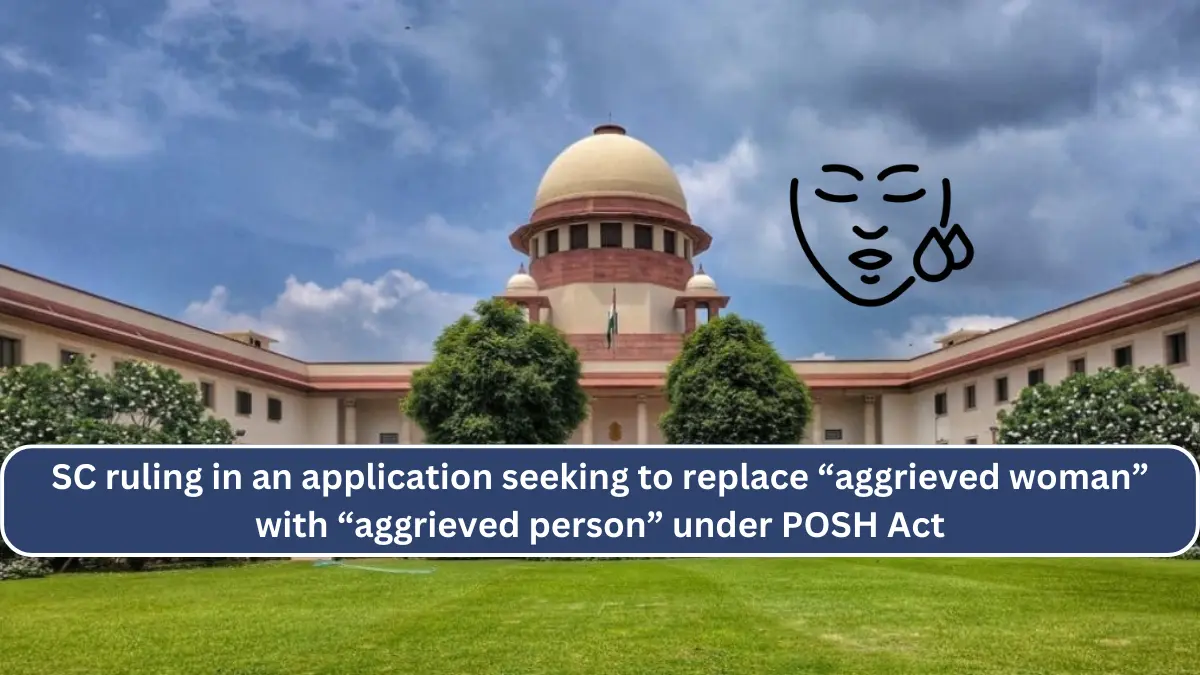Case Name- Binu Tamta & anr. v. High Court of Delhi & ors.
Date of Judgement- 7th November, 2023
Bench- Hon’ble Mrs. Justice B.V. Nagarathna, Hon’ble Mr. Justice Ujjal Bhuyan
Case Overview:
The case involves a Miscellaneous Application (No. 2308/2023) in Writ Petition (Civil) No. 162/2013 at the Supreme Court of India. The application sought gender-neutral amendments to the Regulations for protection against sexual harassment in the workplace, specifically at the Supreme Court. The petitioner, represented by Ms. Vibha Datta Makhija, highlighted the need to extend protection to LGBTQIA+ individuals under the Regulations due to the existing gap in coverage.
However, the Court dismissed the application, emphasizing that the Regulations were primarily designed to protect ‘aggrieved women’ at the Supreme Court. The Court observed limitations on issuing writs to compel legislative or executive actions. The petitioner withdrew the application and expressed intent to approach the Gender Sensitization Committee for formulating new Regulations to address the protection of LGBTQIA+ individuals from workplace harassment.
Facts of the case:
Binu Tamta filed a Miscellaneous Application (No. 2308/2023) seeking changes to workplace sexual harassment regulations at the Supreme Court. Represented by Ms. Vibha Datta Makhija, the petitioner aimed to replace “aggrieved woman” with “aggrieved persons” for gender-neutral protection. The Court recognized the Regulations’ focus on ‘aggrieved women’ but noted a lack of coverage for LGBTQIA+ individuals.
During proceedings, it was highlighted that the existing definition excluded LGBTQIA+ individuals, prompting the petitioner’s argument about the Regulations’ insufficiency. However, the Court, citing legal constraints, emphasized its inability to mandate specific legislative changes. Consequently, the petitioner withdrew the application, expressing intent to address LGBTQIA+ concerns through the Gender Sensitization Committee of the Supreme Court. The Court dismissed the application and any pending matters, allowing for future representation to formulate new Regulations addressing LGBTQIA+ workplace grievances.
Contention of the Involved Parties:
The petitioner contended that the existing Gender Sensitization and Sexual Harassment Regulations at the Supreme Court of India, established in 2013, inadequately protected LGBTQIA+ individuals from workplace sexual harassment. Highlighting the Regulations’ focus on ‘aggrieved women,’ the petitioner argued that individuals within the LGBTQIA+ spectrum were excluded, raising concerns about the absence of specific provisions for their redressal.
Emphasizing the evolving legal landscape and constitutional recognition of LGBTQIA+ rights, the petitioner asserted that the Regulations failed to address the concerns of this marginalized group. The absence of provisions for individuals outside the ‘aggrieved women’ scope was underscored, leading the petitioner to advocate for inclusive amendments. The central contention revolved around the necessity to broaden the Regulations’ protection to create a comprehensive and effective mechanism for addressing workplace sexual harassment, ensuring a safe and inclusive environment for all, regardless of gender identity or sexual orientation.
Court’s observation:
The Court observed that a writ of mandamus cannot be issued to the legislature to enact a particular legislation, nor can it be directed to the executive to make rules, which are considered subordinate legislation. The Court referred to previous judgments emphasizing that a writ court would not direct the Government to consider introducing a specific bill before the House of Legislature within a set time frame.
Furthermore, the Court cited a judgment where it was reiterated that a Constitutional Court would not issue a writ of mandamus to compel a legislature or a rule-making body to enact a law on a specific subject and in a particular manner. This observation underscores the limitations of the Court’s power to direct legislative or executive actions through writs of mandamus.
Overall, the Court’s observations highlight the boundaries of judicial intervention in legislative and executive functions, emphasizing the separation of powers and the limitations on the Court’s authority to dictate the enactment of laws or rules.
Decision:
The Court decided to dismiss the application seeking gender-neutral amendments to the Regulations for protection against sexual harassment in the workplace. They acknowledged that the existing Regulations were formulated to protect ‘aggrieved women’ in the workplace, specifically at the Supreme Court of India. However, the Court also recognized the gap in coverage for LGBTQIA+ individuals who might experience sexual harassment.
Towards the end, the petitioner decided to withdraw the application and indicated their intention to make a representation to the Gender Sensitization Committee of the Supreme Court for the formulation of new Regulations that would address the protection of LGBTQIA+ individuals from sexual harassment in the workplace. As a result, the Court dismissed the application and any pending applications related to the matter.
Conclusion:
In Binu Tamta & anr. v. High Court of Delhi & ors., the Court’s decision, while respecting legal boundaries, leaves a lingering sense of frustration. It underscores the intricate dance between legal structures and evolving societal needs, urging a swifter response to ensure comprehensive protection for marginalized groups. The petitioner’s withdrawal, seeking alternative channels, highlights the persistent struggle to align legal frameworks with the diverse realities of the workplace.
– By Akanksha Chandra Singh ( Dr Ram Manohar Lohiya National Law University, Lucknow )
 Cart is empty
Cart is empty 

